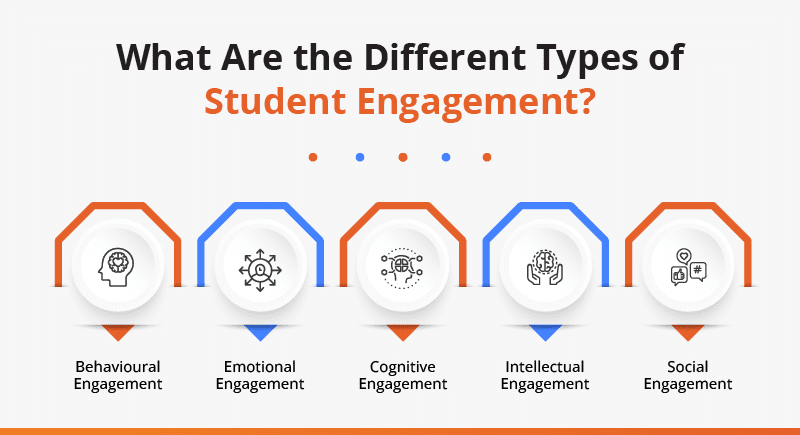What is Student Engagement, and why is it important?

An essential aspect of bettering the learning experience is effective student engagement. When students are more engaged, they are more likely to retain and absorb information. When students demonstrate high levels of engagement in a learning environment, they are more likely to succeed academically and have a positive sense of social-emotional well-being. As an educator, it is your responsibility to employ the best strategies to engage students in class. In this article, we shall explore the various aspects of student engagement, such as its benefits, importance of student engagement, multiple types of engagement, and different activities to engage students in class.
What is Student Engagement?
Student engagement is the student’s attitudes towards school, interpersonal relationships, and disposition towards learning. It manifests through a feeling of connection and participation in school activities. It implies that students participate in academic and co-curricular activities, derive a sense of belonging from the classroom and consider the school their home away from home. Student engagement means students find value in their performance at school and consider the lessons relevant to their short-term and long-term goals.
What Are the Benefits of Student Engagement?
Strategies to promote student engagement in school are the best methods for engaging disengaged students in class. An engaged student is more motivataced, more likely to succeed in the future, and more likely to develop a healthy work ethic that extends beyond their school life. Student engagement is known to pose advantages in terms of better attendance in class, increased motivation, higher focus levels, improved analytical skills and improved classroom behaviour. Teachers who adopt creative ways to engage students are more likely to witness higher classroom participation and an improved student-teacher relationship.
What Are the Different Types of Student Engagement?

Before we get into the various ways to engage students in the classroom, let us first inspect the different types of student engagement. Most teachers, using strategies to promote student engagement, are still able to touch only a few types of engagement. Listed below are the types of student engagement that are necessary to be harnessed to ensure maximum learner retention and motivation in the classroom.
-
Behavioural Engagement:
This covers students’ participation in lessons, such as attendance and concentration levels, as well as their involvement in social aspects of learning and whether or not they engage with extracurricular activities. This aspect of student engagement is measured by the outward behaviour of the students in class and their overall involvement.
-
Emotional Engagement:
This covers students’ feelings, especially towards the subject or course they are studying, their teacher, their peers, their overall academic experience, and whether or not they feel the lessons have value. Whether the student feels free to express their thoughts, feelings, and inner turmoils are all covered under emotional student engagement in the classroom.
-
Cognitive Engagement:
This covers student engagement, motivation and investment in their education. It also includes the extent to which they take ownership of their learning, can self-regulate, and wish to pursue personal educational goals. Whether the students are actually developing mentally and not just learning for memorisation is covered under this type of student engagement. Additionally, students’ analytical and problem-solving skills are also covered.
-
Intellectual Engagement:
This covers the students’ ability to demonstrate their learnings through problem-solving, role-playing or other meaningful exploration activities. The application of ideas and lessons learned comes under this type of student engagement.
-
Social Engagement:
This covers the ability of the student to build a collaborative learning environment through social connections, interaction, teamwork, and sharing.
How Can Student Engagement Be Measured?
Before we learn how to improve student engagement, let us first understand how student engagement can be measured. There are 3 key ways to measure student engagement in schools.
-
Classroom Participation:
How a student participates in classes is often a measure of their engagement. Observe and record their active involvement during class discussions, group activities, and question-answer sessions. You should also consider individual student personalities, as shy students may be less inclined to participate in class actively despite being involved in the subject matter.
-
Undertaking Formal Assessments:
Formal assessments are the most standard method of measuring student engagement. Use tests or exams regularly to measure student progress and highlight areas of weakness for students. You can then utilise this knowledge to help you improve student engagement by changing or altering your lesson plan or testing methods to cater to students with differing learning styles and abilities.
-
Student Feedback:
Anonymous student surveys can provide crucial insights your learners may be apprehensive about sharing openly. You could also ask students to mark their participation each week to establish how engaged they feel they are. By engaging in this type of measurement of student engagement, you gain a much better picture of how engaged your pupils are and how to arm yourself with tips for student engagement to course-correct and start engaging disengaged students quickly.
Activities to Increase Student Engagement:
Now that we have established the importance of student engagement and some ways of measuring it let us explore some activities to increase student engagement and apply our measurement criteria.
-
Establish Goals & Expectations:
One of the ways to engage students in learning is clearly defining goals and academic objectives to help students work towards a set target. Outlining expectations empowers students to create a study plan and abide by it to keep up with peers and improve performance. This will also enable them to complete and share their work on time, which inherently builds accountability.
-
Play With Game-Based Learning:
Unleash the fun in learning by introducing games into the mix! Incorporating game-based learning, such as pop quizzes, brain teasers, puzzles, etc., can be a great way to boost student attention spans and motivation to understand concepts and increase student engagement. Introducing game-based modules at the end of a class is also one of the best practices for student engagement, as it is an effective way to solidify essential topics and revise what was taught.
-
Experiment With Storytelling:
As unreal as it sounds, storytelling makes for an incredibly effective pedagogical approach. By storytelling, we don’t necessarily mean that teachers need to incorporate fairy tales as part of their lesson plans. But, they can illustrate concepts, ideas and information by narrating an intriguing story about them. This makes the learning material more appealing and is among the best classroom activities to engage students.
-
Level Up With Brainstorming Activities:
Brainstorming is a great exercise to help students develop problem-solving skills. Simply knowing that they need to reflect and report back with ideas on a topic gets students excited and motivated to learn more. This will also help them develop their unique perspectives and express their ideas. Brainstorming is also one of the easiest and most creative ways to engage students and works effectively in both short & long lectures as well as online & offline classes.
-
Use the Think, Pair & Share Approach:
These innovative strategies to promote student engagement equip students with problem-solving, creativity and collaboration skills. Here, teachers divide the classroom into different groups and encourage them to discuss a given topic. Using an online whiteboard, each group visually shares their views. The entire class then collectively indulges in discussions and peer assessments over the final results. This exercise is great if you want to encourage students to think out of the box and develop h3 critical thinking skills.
-
Experiment With Hands-on Activities:
Hands-on activities in the classroom can be an ideal way to increase student engagement in school and to fill in black spaces like ‘dead time’- a point during the lecture where students are left with nothing to do. This is usually when teachers are distributing worksheets, setting up a presentation, etc. – which is when most students end up getting distracted. Keeping students busy with in-class assignments, research, open book tests, or simply going over reading material are great hands-on activities to keep up their attention spans and enable classroom involvement.
-
Introduce Project-Based Learning:
This student-centred pedagogy involves working on real-world projects individually or in groups, creating a dynamic learning environment, and ensuring effective student engagement. Project-based learning helps students develop their knowledge and ability to solve complex problems by reflecting on open-ended questions, being part of engaging discussions and drawing valuable conclusions. It also brings about an element of fun and gets students excited to attend classes and learn more.
-
Integrate Mixed Media:
Incorporating a variety of learning mediums such as video, audio, and digital media are among the best classroom activities to engage students. It helps address the academic needs of varied types of learners. Moreover, it promotes student engagement during classes and helps them understand and retain concepts better.
-
Implement The Flipped Classroom Model:
The flipped classroom approach is known to boost student engagement and motivation and maximise time for active learning. This unique instructional strategy involves indulging students in pre-class activities such as watching a video, reading a case study, and essentially familiarising themselves with a topic to be better prepared for in-class learning. It gives them the time to develop higher-order thinking skills and create space for collaboration during classes.
-
Explore Inquiry-Based Learning:
The main essence of inquiry-based learning lies in triggering the curiosity of each student. This approach focuses on going beyond the initial ‘why’ of questions and makes real-world connections that are intentional and backed by research. Students take the initiative to find answers, conduct research, make predictions and indulge in discussions, reflecting further on the topic at hand. This is one of the crucial tips for student engagement that has a long-term impact on their academic excellence.
Boost student engagement even further with these dynamic Smart Classroom Activities.

Boost Student Engagement With Curated Activities for Your Classroom!
✓ 60+ activities across 6 different engagement categories
✓ Designed for grades 3 to 12 and easy to plug into any lesson plan
✓ Comes with printable cards and step-by-step instructions
How Does Extramarks Support Teachers in Creating a Thriving Classroom Environment?
The Extramarks platform provides educators with a 360-degree holistic teaching experience. Ranging from interactive media-rich digital content to real-time polls, chat rooms and recorded lectures, teachers can enjoy the benefits of it all with Smart Class Plus. The main benefit of getting access to cutting-edge edtech solutions is that teachers can curate captivating lectures using interactive learning tools like brain teasers, animated lessons and pop quizzes. These essentially make for great activities to engage students.
Besides this, active learning features like chapter-based prompts and post-topic completion are a sure-shot way to assess learners’ understanding in real time. It gives teachers an insight into a student’s progress and helps them curate a study plan based on their learning needs.
With access to such fun and dynamic features, Extramarks Smart Class Plus makes for the perfect platform to help teachers boost student engagement.
Learn MoreTeachers need to be intentional about creating a dynamic learning environment that not only supports but enables interaction and student engagement. When students feel supported and encouraged in the classroom, there are indeed no bounds to the academic growth and development that they can achieve!
Last Updated on April 8, 2025
Reviewed by

Priya Kapoor | AVP - Academics
Priya Kapoor is an accomplished education professional with over 18 years of experience across diverse fields, including eLearning, digital and print publishing, instructional design, and content strategy. As the AVP – Academics at Extramarks, she leads academic teams in creating tailored educational solutions, ensuring alignment with varied curricula across national and international platforms...read more.











